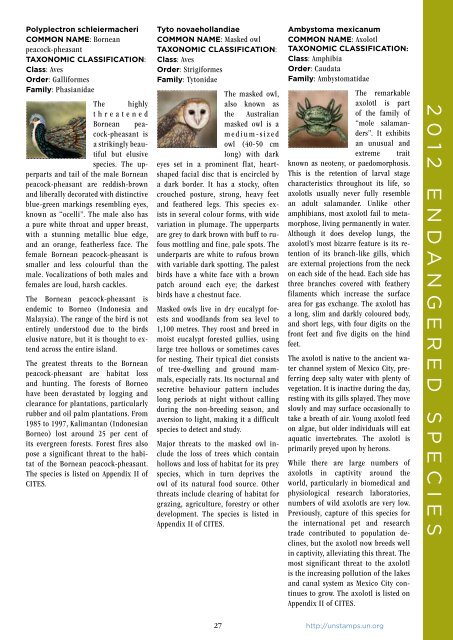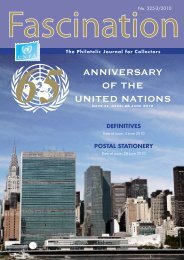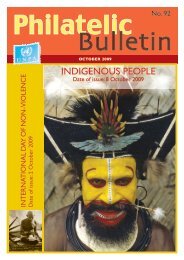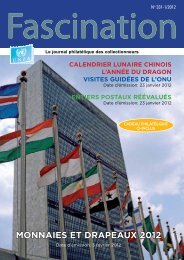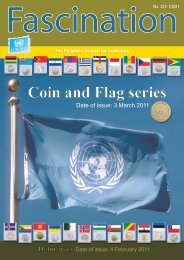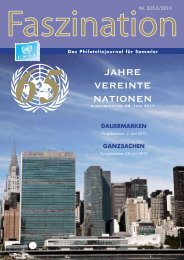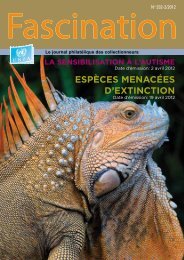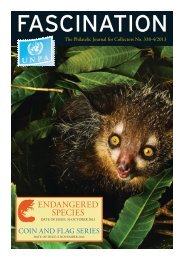endangered species - United Nations Postal Administration - ONU
endangered species - United Nations Postal Administration - ONU
endangered species - United Nations Postal Administration - ONU
You also want an ePaper? Increase the reach of your titles
YUMPU automatically turns print PDFs into web optimized ePapers that Google loves.
Polyplectron schleiermacheri<br />
COMMON NAME: Bornean<br />
peacock-pheasant<br />
TAXONOMIC CLASSIFICATION:<br />
Class: Aves<br />
Order: Galliformes<br />
Family: Phasianidae<br />
The highly<br />
threatened<br />
Bornean peacock-pheasant<br />
is<br />
a strikingly beautiful<br />
but elusive<br />
<strong>species</strong>. The upperparts<br />
and tail of the male Bornean<br />
peacock-pheasant are reddish-brown<br />
and liberally decorated with distinctive<br />
blue-green markings resembling eyes,<br />
known as “ocelli”. The male also has<br />
a pure white throat and upper breast,<br />
with a stunning metallic blue edge,<br />
and an orange, featherless face. The<br />
female Bornean peacock-pheasant is<br />
smaller and less colourful than the<br />
male. Vocalizations of both males and<br />
females are loud, harsh cackles.<br />
The Bornean peacock-pheasant is<br />
endemic to Borneo (Indonesia and<br />
Malaysia). The range of the bird is not<br />
entirely understood due to the birds<br />
elusive nature, but it is thought to extend<br />
across the entire island.<br />
The greatest threats to the Bornean<br />
peacock-pheasant are habitat loss<br />
and hunting. The forests of Borneo<br />
have been devastated by logging and<br />
clearance for plantations, particularly<br />
rubber and oil palm plantations. From<br />
1985 to 1997, Kalimantan (Indonesian<br />
Borneo) lost around 25 per cent of<br />
its evergreen forests. Forest fires also<br />
pose a significant threat to the habitat<br />
of the Bornean peacock-pheasant.<br />
The <strong>species</strong> is listed on Appendix II of<br />
CITES.<br />
Tyto novaehollandiae<br />
COMMON NAME: Masked owl<br />
TAXONOMIC CLASSIFICATION:<br />
Class: Aves<br />
Order: Strigiformes<br />
Family: Tytonidae<br />
The masked owl,<br />
also known as<br />
the Australian<br />
masked owl is a<br />
medium-sized<br />
owl (40-50 cm<br />
long) with dark<br />
eyes set in a prominent flat, heartshaped<br />
facial disc that is encircled by<br />
a dark border. It has a stocky, often<br />
crouched posture, strong, heavy feet<br />
and feathered legs. This <strong>species</strong> exists<br />
in several colour forms, with wide<br />
variation in plumage. The upperparts<br />
are grey to dark brown with buff to rufous<br />
mottling and fine, pale spots. The<br />
underparts are white to rufous brown<br />
with variable dark spotting. The palest<br />
birds have a white face with a brown<br />
patch around each eye; the darkest<br />
birds have a chestnut face.<br />
Masked owls live in dry eucalypt forests<br />
and woodlands from sea level to<br />
1,100 metres. They roost and breed in<br />
moist eucalypt forested gullies, using<br />
large tree hollows or sometimes caves<br />
for nesting. Their typical diet consists<br />
of tree-dwelling and ground mammals,<br />
especially rats. Its nocturnal and<br />
secretive behaviour pattern includes<br />
long periods at night without calling<br />
during the non-breeding season, and<br />
aversion to light, making it a difficult<br />
<strong>species</strong> to detect and study.<br />
Major threats to the masked owl include<br />
the loss of trees which contain<br />
hollows and loss of habitat for its prey<br />
<strong>species</strong>, which in turn deprives the<br />
owl of its natural food source. Other<br />
threats include clearing of habitat for<br />
grazing, agriculture, forestry or other<br />
development. The <strong>species</strong> is listed in<br />
Appendix II of CITES.<br />
Ambystoma mexicanum<br />
COMMON NAME: Axolotl<br />
TAXONOMIC CLASSIFICATION:<br />
Class: Amphibia<br />
Order: Caudata<br />
Family: Ambystomatidae<br />
The remarkable<br />
axolotl is part<br />
of the family of<br />
“mole salamanders”.<br />
It exhibits<br />
an unusual and<br />
extreme trait<br />
known as neoteny, or paedomorphosis.<br />
This is the retention of larval stage<br />
characteristics throughout its life, so<br />
axolotls usually never fully resemble<br />
an adult salamander. Unlike other<br />
amphibians, most axolotl fail to metamorphose,<br />
living permanently in water.<br />
Although it does develop lungs, the<br />
axolotl’s most bizarre feature is its retention<br />
of its branch-like gills, which<br />
are external projections from the neck<br />
on each side of the head. Each side has<br />
three branches covered with feathery<br />
filaments which increase the surface<br />
area for gas exchange. The axolotl has<br />
a long, slim and darkly coloured body,<br />
and short legs, with four digits on the<br />
front feet and five digits on the hind<br />
feet.<br />
The axolotl is native to the ancient water<br />
channel system of Mexico City, preferring<br />
deep salty water with plenty of<br />
vegetation. It is inactive during the day,<br />
resting with its gills splayed. They move<br />
slowly and may surface occasionally to<br />
take a breath of air. Young axolotl feed<br />
on algae, but older individuals will eat<br />
aquatic invertebrates. The axolotl is<br />
primarily preyed upon by herons.<br />
While there are large numbers of<br />
axolotls in captivity around the<br />
world, particularly in biomedical and<br />
physiological research laboratories,<br />
numbers of wild axolotls are very low.<br />
Previously, capture of this <strong>species</strong> for<br />
the international pet and research<br />
trade contributed to population declines,<br />
but the axolotl now breeds well<br />
in captivity, alleviating this threat. The<br />
most significant threat to the axolotl<br />
is the increasing pollution of the lakes<br />
and canal system as Mexico City continues<br />
to grow. The axolotl is listed on<br />
Appendix II of CITES.<br />
2012 ENDANGERED SPECIES<br />
27 http://unstamps.un.org


